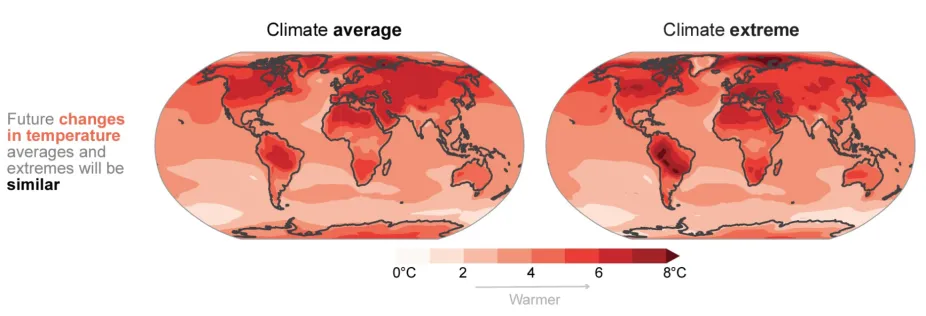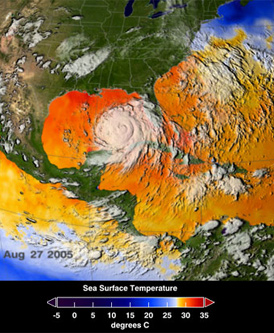Climate Change: Regional Impacts
Changes in Earth's climate have different effects in different areas of the world. Some places will warm much more than others, some regions will receive more rainfall, while others are exposed to more frequent droughts. Regional changes in temperature and precipitation are having impacts on people and ecosystems. Animals that are not able to tolerate changes in climate and are not able to move into new areas are threatened by extinction.
Warming Temperatures

Warming is already occurring in all areas of the globe, but models of future temperatures show that the changes will not be distributed equally. Polar regions and land areas are expected to see the largest temperature changes.
IPCC Working Group I, 2021
Earth's average global temperature is rising, but the amount of warming is not equal in all areas of the world.
- As the climate warms, the ocean is expected to warm more slowly than land because it takes much more heat to warm water than air and land. The air right above ocean water are expected to warm more slowly than land too.
- In general, the middle of continents are expected to warm more than coastal areas. Regional topography such as mountain ranges will influence this too.
- At high latitudes, especially in and near the Arctic, temperatures are warming faster than places closer to the equator. The Arctic is heating up about twice as quickly as the global average.
Changing Regional Precipitation

Future changes in precipitation will vary regionally, with some parts of the globe likely to become wetter and other areas projected to become drier.
IPCC Working Group I, 2021
As temperatures continues to warm, global average precipitation will also increase by the end of the century. This increase is not, however, expected to be distributed evenly around the globe or throughout the seasons in a given year. Many parts of the world could experience increases in the frequency and intensity of extreme, heavy rain events, and in other parts of the world, dry conditions may become more severe and last longer.
Much of the increase in precipitation is expected to occur at high latitudes. Increased snowfall near both poles may offset some of the melting of glaciers and ice sheets in these regions by adding fresh ice to the tops of these features. Some places in Antarctica are even gaining more snow via increased precipitation than they are losing to melting caused by rising temperatures.
However, many regions near the equator and at mid-latitudes are expected to see decreases in precipitation. In Africa, between 75 and 250 million people are projected to be vulnerable to drought and lack of drinking water. Dry conditions are already making it difficult to grow crops in Africa, which is causing more food scarcity. In some areas of Asia, clean freshwater is projected to become more scarce, and illness caused by unclean water is projected to increase.
Some of the increased rainfall is expected to come in the form of more frequent heavy downpours. Some regions may receive a net increase in rainfall, but the increase may manifest itself as heavier rains punctuated by longer dry spells between these deluges. This change in precipitation patterns is likely to cause a greater incidence of flooding, especially in combination with land use changes such as deforestation.
Many areas, especially in low- and mid-latitude regions, are expected to suffer from more frequent and more severe droughts. Dry conditions, warmer temperatures that produce longer "fire seasons", and changes to ecosystems are expected to generate more and larger wildfires in some areas.
Some presently dry regions may be glad to see increased rainfall, just as drier conditions may benefit some currently very wet places. However, heavy rainfall that causes flooding as well as extended or more frequent droughts are likely to be disruptive to ecosystems and agriculture in the afflicted regions.
Low-lying Coastal Regions and Rising Seas
Not surprisingly, rising sea level is expected to have adverse effects on coastal regions and islands worldwide. However, the impacts will differ depending on the topography of the land and its susceptibility to flooding.
Some low-lying coastal regions will be subject to more frequent flooding or even permanent inundation. Large areas in the countries of Bangladesh and The Netherlands, along with the U.S. state of Florida and the city of New Orleans are only slightly above sea level, and thus are at great risk of even slight increases in sea level. Some small island nations in the Pacific are at such low elevations that they are in danger of being wiped off the map entirely as the water rises.
Higher sea levels will hasten the erosion of beaches and other types of terrain along the shoreline. Salty water will seep further inland in estuaries and brackish marshes, altering ecosystems (many of which serve as nurseries for ocean-going fish and other aquatic creatures).
Hurricane Prone Regions

Regions of the world that are already prone to tropical cyclones (also known as hurricanes and typhoons) may see more impacts from them in the future. These storms derive their energy from warm ocean waters, so their winds become more intense as sea surface temperatures warm. Hurricanes are also able to carry more water vapor in a warmer climate, causing more rain which can cause flooding when they make landfall. Also, flooding from storm surge during hurricanes will wash further inland as sea level rises due to climate change.
Hurricanes occur in six major regions worldwide: the North Atlantic, the Northeastern Pacific, the Northwestern Pacific, the Southwestern Pacific, and the North and South Indian Ocean. Each of these regions may be affected differently by changes to storm patterns caused by global warming. Hurricane seasons may start earlier and end later, providing more time for storms to occur. Storms may move into higher latitudes as ocean waters warm. Hurricanes may form in places where they hadn't before.
- Teaching Resource: The Hurricanes and Climate activity has learners looking at hurricane data and how warming may be affecting the strength of storms.
High Mountain Regions
Almost all of the world's mountain or alpine glaciers are receding, a trend that is likely to continue in the years ahead. As glaciers shrink, and in some places disappear, human communities and ecosystems that rely on glacial meltwater as a supply of fresh water. In some regions, people depend almost entirely on glaciers for the water they use in towns, cities, and for agriculture. Much of northern India gets water from Himalayan glaciers, while large portions of Chile rely on glaciers in the Andes for water. Less water can lead to changes in ecosystems and a greater incidence of water-borne diseases. In other mountainous areas, snow typically builds up during the winter and melts in the spring and summer, flowing down rivers. But warmer temperatures increase the risk of river flooding as snow melts faster. The changes to snow and glacial ice in mountain regions threatens the extinction of species that live in unique high-altitude environments.
Regions Affected by El Niño and Other Patterns in the Atmosphere
Cycles such as El Niño and La Niña events and seasonal monsoons in India may change as the climate warms. Scientists are still trying to improve models of these events, so predictions of how they may change in the future are somewhat speculative. Disruptions of the normal patterns, particularly of the monsoons, could affect many millions of people in areas like India and Bangladesh. El Niño and La Niña affect the Pacific Ocean and surrounding areas, but scientists are discovering that they also may have an influence on other areas of the world as well.
The Polar Regions
The Arctic and parts of Antarctica are warming much more quickly than the global average, a trend that is expected to continue. The extent of sea ice in the Arctic Ocean has been decreasing rapidly. Some models project a complete loss of sea ice in the summertime in the Arctic by the middle of the 21st Century. Glaciers and ice sheets in Antarctica and Greenland are melting too.
Permafrost (frozen ground) usually provides a solid platform for buildings and roadways in the Arctic. It is solid enough for animals like caribou to migrate over. But thawing permafrost creates mushy ground, disrupting wildlife and human activities. Also, the thawing of permafrost releases methane, a powerful greenhouse gas.